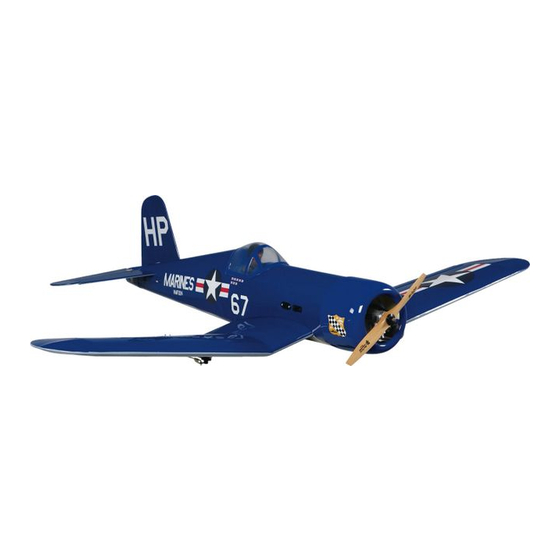- ページ 18
おもちゃ GREAT PLANES Combat CorsairのPDF 取扱説明書をオンラインで閲覧またはダウンロードできます。GREAT PLANES Combat Corsair 20 ページ。 1/12 scale ama event 750, class 2610 arf

CHECK LIST
1. Fuelproof all areas exposed to fuel or exhaust residue
such as the cowl ring, wing saddle area, etc.
2. Check the C.G. according to the measurements
provided in the manual.
3. Be certain the battery and receiver are securely
mounted in the fuse. Simply stuffing them into place with
foam rubber is not sufficient.
4. Extend your receiver antenna and make sure it has a
strain relief inside the fuselage to keep tension off the
solder joint inside the receiver.
5. Balance your model laterally as explained in the
instructions.
6. Use threadlocking compound to secure critical
fasteners such as the set screws that hold the screws
that hold the carburetor arm (if applicable), screw-lock
pushrod connectors, etc.
7. Make sure all hinges are securely glued in place.
8. Reinforce holes for wood screws with thin CA where
appropriate (servo mounting screws, cowl mounting
screws, etc.).
9. Confirm that all controls operate in the correct direction
and the throws are set up according to the manual.
10. Make sure there are silicone retainers on all the
clevises and that all servo arms are secured to the
servos with the screws included with your radio.
11. Secure connections between servo wires and
Y-connectors or servo extensions and the connection
between your battery pack and the on/off switch with
vinyl tape, heat shrink tubing or special clips suitable for
that purpose.
12. Make sure any servo extension cords you may have
used do not interfere with other systems (servo arms,
pushrods, etc.).
13. Secure the pressure tap (if used) to the muffler with
high temp RTV silicone, thread locking compound or J.B.
Weld.
14. Make sure the fuel lines are connected and are
not kinked.
15. Balance your propeller (and spare propellers).
16. Tighten the propeller nut and spinner.
17. Place your name, address, AMA number and
telephone number on or inside your model.
18. Cycle your receiver battery pack (if necessary) and
make sure it is fully charged.
19. If you wish to photograph your model, do so before
your first flight.
20. Range check your radio when you get to the flying field.
Flying a model with too few rubber bands can be
dangerous. If the wing momentarily lifts from the
fuselage and acts as though a large amount of "up"
elevator has suddenly been applied because there are
not enough rubber bands or they are too weak, internal
structural damage may result. Even worse, the wing
could actually detach from the fuselage resulting in a
crash. If the model exhibits any tendencies that indicate
there are not enough rubber bands, immediately reduce
power, land and closely inspect the model for damage.
If no damage is found, add more rubber bands.
The Combat Corsair is a great-flying model that flies smoothly
and predictably. The Combat Corsair does not, however,
possess the self-recovery characteristics of a primary R/C
trainer and should be flown only by experienced R/C pilots.
Fuel Mixture Adjustments
A fully cowled engine may run at a higher temperature than
an un-cowled engine. For this reason, the fuel mixture
should be richened so the engine runs at about 200 rpm
below peak speed. By running the engine slightly rich, you
will help prevent dead-stick landings caused by overheating.
CAUTION (THIS APPLIES TO ALL R/C AIRPLANES): If,
while flying, you notice an alarming or unusual sound
such as a low-pitched "buzz," this may indicate control
surface flutter. Flutter occurs when a control surface (such
as an aileron or elevator) or a flying surface (such as a
wing or stab) rapidly vibrates up and down (thus causing
the noise). In extreme cases, if not detected immediately,
flutter can actually cause the control surface to detach or
the flying surface to fail, thus causing loss of control
followed by an impending crash. The best thing to do
when flutter is detected is to slow the model immediately
by reducing power, then land as soon as safely possible.
Identify which surface fluttered (so the problem may be
resolved) by checking all the servo grommets for
deterioration or signs of vibration. Make certain all
pushrod linkages are secure and free of play. If it fluttered
once, under similar circumstances it will probably flutter
again unless the problem is fixed. Some things which can
cause flutter are; Excessive hinge gap; Not mounting
control horns solidly; Poor fit of clevis pin in horn; Side-
play of wire pushrods caused by large bends; Excessive
free play in servo gears; Insecure servo mounting; and
one of the most prevalent causes of flutter; Flying an over-
powered model at excessive speeds.
18
FLYING
IMPORTANT!!!
